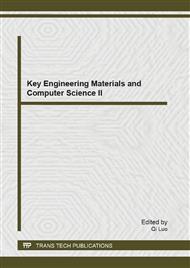[1]
Sultan Ullah, Zheng Xuefeng."Cloud Computing: a Prologue." International Journal of Advanced Research in Computer and Communication Engineering 1. No. 1 (2012)
Google Scholar
[2]
Kandukuri, Balachandra Reddy, V. Ramakrishna Paturi, and Atanu Rakshit. "Cloud security issues." In Services Computing, 2009. SCC'09. IEEE International Conference on, pp.517-520. IEEE, 2009.
DOI: 10.1109/scc.2009.84
Google Scholar
[3]
Ullah, Sultan, Zheng Xuefeng, Zhou Feng, and Zhao Haichun. "Tcloud: Challenges And Best Practices For Cloud Computing." International Journal of Engineering 1, no. 9 (2012).
Google Scholar
[4]
He, Rui, Jianwei Niu, and Guangwei Zhang. "CBTM: A trust model with uncertainty quantification and reasoning for pervasive computing." Parallel and Distributed Processing and Applications (2005): 541-552.
DOI: 10.1007/11576235_56
Google Scholar
[5]
Dragoni, Nicola. "Toward trustworthy web services-approaches, weaknesses and trust-by-contract framework." In Web Intelligence and Intelligent Agent Technologies, 2009. WI-IAT'09. IEEE/WIC/ACM International Joint Conferences on, vol. 3, pp.599-606. IET, 2009.
DOI: 10.1109/wi-iat.2009.359
Google Scholar
[6]
Ying-feng, Zhong, and Shao Pei-ji. "The model for consumer trust in c2c online auction." In Management Science and Engineering, 2006. ICMSE'06. 2006 International Conference on, pp.125-129. IEEE, 2006.
DOI: 10.1109/icmse.2006.313894
Google Scholar
[7]
Huhns, Michael N., and Munindar P. Singh. "Service-oriented computing: Key concepts and principles." Internet Computing, IEEE 9, no. 1 (2005): 75-81.
DOI: 10.1109/mic.2005.21
Google Scholar
[8]
Kalepu, Sravanthi, Shonali Krishnaswamy, and Seng Wai Loke. "Verity: a QoS metric for selecting Web services and providers." In Web Information Systems Engineering Workshops, 2003. Proceedings. Fourth International Conference on, pp.131-139. IEEE, 2003.
DOI: 10.1109/wisew.2003.1286795
Google Scholar
[9]
Wei, Wang, and Zeng GuoSun. "Trusted dynamic level scheduling based on Bayes trust model." Science in China Series F: Information Sciences 50, no. 3 (2007): 456-469.
DOI: 10.1007/s11432-007-0021-x
Google Scholar
[10]
Wang, Jian Ping, Hui Ying Cao, Jin Ling Wang, and Cheng Hui Zhu. "Research of Off-Line Handwritten Chinese Character Recognition System Based on Feedback Structure." Advanced Materials Research 433 (2012): 7046-7053.
DOI: 10.4028/www.scientific.net/amr.433-440.7046
Google Scholar
[11]
Sabater, Jordi, and Carles Sierra. "Review on computational trust and reputation models." Artificial Intelligence Review 24, no. 1 (2005): 33-60.
DOI: 10.1007/s10462-004-0041-5
Google Scholar
[12]
Stephen, Marsh. "Formalising trust as a computational concept." Ph.D dissertation. University of Stirling, scotland (1994).
Google Scholar
[13]
Xiu, Daoxi, and Zhaoyu Liu. "A formal definition for trust in distributed systems."Information Security (2005): 482-489.
Google Scholar
[14]
Bonatti, Piero, Claudiu Duma, Daniel Olmedilla, and Nahid Shahmehri. "An integration of reputation-based and policy-based trust management." networks2, no. 14 (2007): 10.
Google Scholar
[15]
Artz, Donovan, and Yolanda Gil. "A survey of trust in computer science and the semantic web." Web Semantics: Science, Services and Agents on the World Wide Web 5, no. 2 (2007): 58-71.
DOI: 10.1016/j.websem.2007.03.002
Google Scholar
[16]
Ramchurn, Sarvapali, Carles Sierra, Lluıs Godó, and Nicholas R. Jennings. "A computational trust model for multi-agent interactions based on confidence and reputation." (2003): 69-75.
Google Scholar
[17]
Yu, Bin, and Munindar P. Singh. "Distributed reputation management for electronic commerce." Computational Intelligence 18, no. 4 (2002): 535-549.
DOI: 10.1111/1467-8640.00202
Google Scholar


